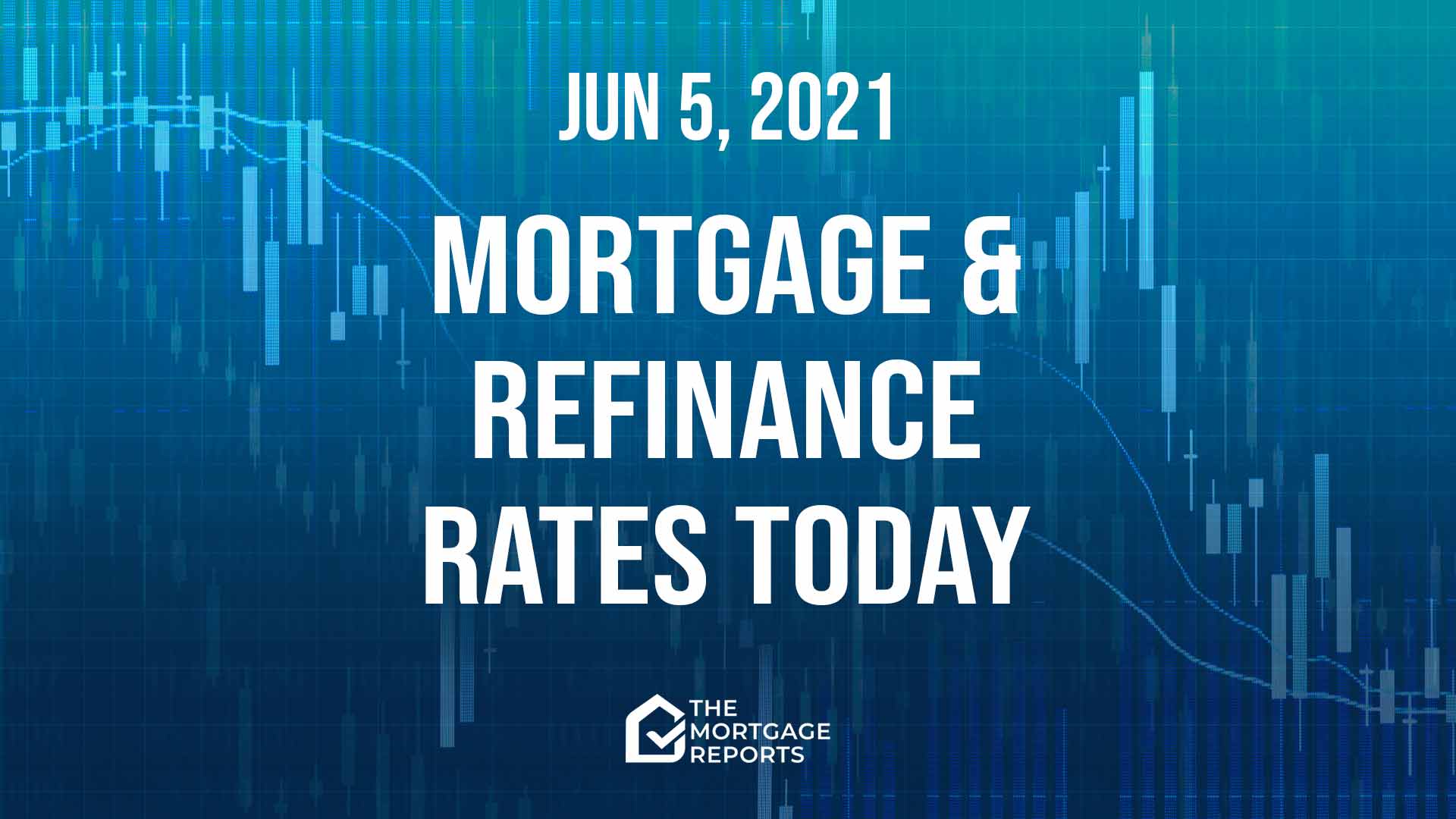
Today’s mortgage and refinance rates
Average mortgage rates ended up holding steady yesterday. That morning, they’d looked likely to fall as a result of the employment report. But they ended up back where they started.
Based on recent activity, I’m expecting mortgage rates next week to barely move. Yes, they’ll likely go up and down on different days. But we’ll be unlucky if the sustained rises I’m expecting begin then.
Find and lock a low rate (Jun 5th, 2021)Current mortgage and refinance rates
| Program | Mortgage Rate | APR* | Change |
|---|---|---|---|
| Conventional 30 year fixed | |||
| Conventional 30 year fixed | 2.874% | 2.874% | -0.06% |
| Conventional 15 year fixed | |||
| Conventional 15 year fixed | 2.2% | 2.2% | -0.04% |
| Conventional 20 year fixed | |||
| Conventional 20 year fixed | 2.75% | 2.75% | -0.03% |
| Conventional 10 year fixed | |||
| Conventional 10 year fixed | 1.951% | 1.988% | -0.04% |
| Conventional 5 year ARM | |||
| Conventional 5 year ARM | 3.625% | 3.224% | +0.05% |
| 30 year fixed FHA | |||
| 30 year fixed FHA | 2.695% | 3.351% | -0.05% |
| 15 year fixed FHA | |||
| 15 year fixed FHA | 2.422% | 3.023% | -0.04% |
| 5 year ARM FHA | |||
| 5 year ARM FHA | 2.5% | 3.188% | Unchanged |
| 30 year fixed VA | |||
| 30 year fixed VA | 2.346% | 2.518% | -0.03% |
| 15 year fixed VA | |||
| 15 year fixed VA | 2.25% | 2.571% | Unchanged |
| 5 year ARM VA | |||
| 5 year ARM VA | 2.5% | 2.366% | Unchanged |
| Rates are provided by our partner network, and may not reflect the market. Your rate might be different. Click here for a personalized rate quote. See our rate assumptions here. | |||
COVID-19 mortgage updates: Mortgage lenders are changing rates and rules due to COVID-19. To see the latest on how coronavirus could impact your home loan, click here.
Should you lock a mortgage rate today?
Although the daily ups and downs of mortgage rates can make you feel happy or blue, they’ve been going nowhere recently.
Just look at Freddie Mac‘s average weekly rate for 30-year, fixed-rate mortgages for the last few weeks. It stood at 2.96% on May 6, 2.94% the following week, then 3%, 2.95% and, on Thursday, 2.99%. Nobody’s getting rich on such minute changes.
But readers who are still floating are shouldering a lot of risk for those small potential rewards. Because nearly all economists and industry analysts are expecting sustained rises soon. They just don’t know when.
And that’s why my personal recommendations remain:
- LOCK if closing in 7 days
- LOCK if closing in 15 days
- LOCK if closing in 30 days
- LOCK if closing in 45 days
- LOCK if closing in 60 days
However, with so much uncertainty at the moment, your instincts could easily turn out to be as good as mine — or better. So be guided by your gut and your personal tolerance for risk.
What’s moving current mortgage rates
Yesterday’s jobs report (formally called “the employment situation report”) for May was way better than April’s. Payrolls rose by 559,000 last month compared with 278,000 the previous month. And the unemployment rate fell to 5.8% in May from 6.1% the prior month.
In normal times, that would be considered excellent. But we’re in the midst of an economic recovery. And employment is lagging other data.
In a statement yesterday, US Secretary of Labor Marty Walsh identified the reasons he thinks employment growth was slower than many expected. And he spoke of:
… the challenges they [workers] and their families face — finding affordable childcare, caring for elderly parents and grandparents, and overcoming the hurdles raised by decades of income inequality and race- and gender-based inequity. These challenges are also reflected in our jobs data, and they are why the American Jobs Plan and the American Families Plan are so important. We need to invest in our workforce and our communities to achieve an inclusive recovery and a competitive economy.
— US Dept. of Labor, “Statement by US Secretary of Labor Walsh on the May Jobs Report,” June 4, 2021
Of course, others take a different view, arguing that elevated unemployment benefits disincentivize workers from taking poorly paid jobs.
What this means for mortgage rates
Normally, a better-than-expected jobs report would send mortgage rates modestly higher. But yesterday’s was worse than expected and the morning began with mortgage rates a little lower. Still, they recovered to be unchanged by the end of the day. Perhaps investors agreed with Yale economist Paul Krugman who wrote for yesterday’s New York Times:
Don’t pay too much attention to today’s jobs report; it came in slightly below expectations, but given the noisiness of the data (and the extent to which the numbers are often revised), it told us very little that we didn’t already know.
But what would have happened had yesterday’s report had beaten all expectations, with, say, 1 million new jobs? That might well have triggered the sustained mortgage rate rises many of us are expecting.
Fed still front and center
However, that wouldn’t just have been for the usual reason: Mortgage rates tend to be higher the better the economy is doing. Rates would probably have received a turbo boost from a renewed expectation that the Federal Reserve would be forced to end its asset-purchasing program early. And, the last time that happened, mortgage rates shot up. You can read more about that so-called taper tantrum in a recent version of this weekend edition.
So it may be that yesterday’s so-so jobs report has given borrowers an extension of the current doldrums that have becalmed mortgage rates. Of course, other events could arise that kick start higher rates sooner. But we may be able to wait for next month’s report of June employment data before we’re so fearful of appreciably higher rates again.
Nothing’s certain
The late Harvard economist John Kenneth Galbraith once observed:
The only function of economic forecasting is to make astrology look respectable.
And he was right. Economists can pontificate all they like. But events can overtake any model and make forecasters look silly.
All you and I can do is weigh the likely odds of future scenarios occurring. And, right now, higher mortgage rates look distinctly probable — and quite soon.
But they’re not inevitable. Still, I wouldn’t wager the size of my future monthly mortgage payments on the hope that something unlikely comes along that pushes them lower.
Economic reports next week
Employment may be one factor obsessing markets but inflation is the other. And Thursday brings a key indicator of the latter. That’s the consumer price index (CPI) and the core CPI figure, which is the CPI with volatile food and energy prices stripped out.
But the others listed below are unlikely to cause much movement in markets unless they include shockingly good or bad data. Moreover, regular readers will know that markets have been ignoring most economic reports in recent weeks. So the effects of the following may be different from usual:
- Tuesday — April job openings and trade deficit. Plus May small-business survey
- Thursday — Consumer price index (CPI) for May along with core CPI. Plus weekly new claims for unemployment insurance
- Friday — June consumer sentiment index
This week, keep an eye on Thursday.
Find and lock a low rate (Jun 5th, 2021)
Mortgage interest rates forecast for next week
After so few meaningful movements in recent weeks, we may well be in for another unexciting period. So I’m expecting that mortgage rates next week will be unchanged or barely changed. But it’s always possible that something will tip the balance and push mortgage rates appreciably lower — or, more likely, higher.
Mortgage and refinance rates usually move in tandem. But note that refinance rates are currently a little higher than those for purchase mortgages. That gap’s likely to remain fairly constant as they change.
Meanwhile, a recent regulatory change has made most mortgages for investment properties and vacation homes more expensive.
How your mortgage interest rate is determined
Mortgage and refinance rates are generally determined by prices in a secondary market (similar to the stock or bond markets) where mortgage-backed securities are traded.
And that’s highly dependent on the economy. So mortgage rates tend to be high when things are going well and low when the economy’s in trouble.
Your part
But you play a big part in determining your own mortgage rate in five ways. You can affect it significantly by:
- Shopping around for your best mortgage rate — They vary widely from lender to lender
- Boosting your credit score — Even a small bump can make a big difference to your rate and payments
- Saving the biggest down payment you can — Lenders like you to have real skin in this game
- Keeping your other borrowing modest — The lower your other monthly commitments, the bigger the mortgage you can afford
- Choosing your mortgage carefully — Are you better off with a conventional, FHA, VA, USDA, jumbo or another loan?
Time spent getting these ducks in a row can see you winning lower rates.
Remember, it’s not just a mortgage rate
Be sure to count all your forthcoming homeownership costs when you’re working out how big a mortgage you can afford. So focus on your “PITI” That’s your Principal (pays down the amount you borrowed), Interest (the price of borrowing), (property) Taxes, and (homeowners) Insurance. Our mortgage calculator can help with these.
Depending on your type of mortgage and the size of your down payment, you may have to pay mortgage insurance, too. And that can easily run into three figures every month.
But there are other potential costs. So you’ll have to pay homeowners association dues if you choose to live somewhere with an HOA. And, wherever you live, you should expect repairs and maintenance costs. There’s no landlord to call when things go wrong!
Finally, you’ll find it hard to forget closing costs. You can see those reflected in the annual percentage rate (APR) you’ll be quoted. Because that effectively spreads them out over your loan’s term, making that higher than your straight mortgage rate.
But you may be able to get help with those closing costs your down payment, especially if you’re a first-time buyer. Read:
Down payment assistance programs in every state for 2021



